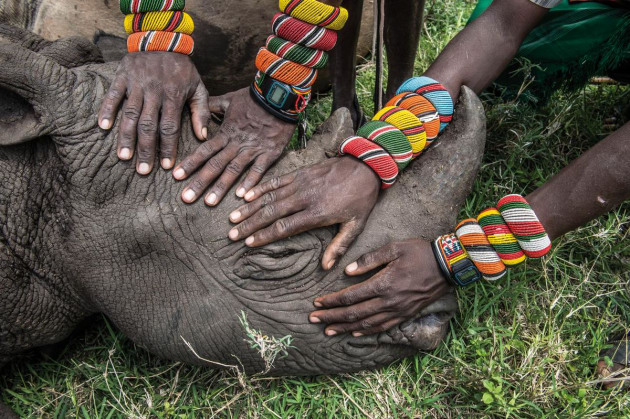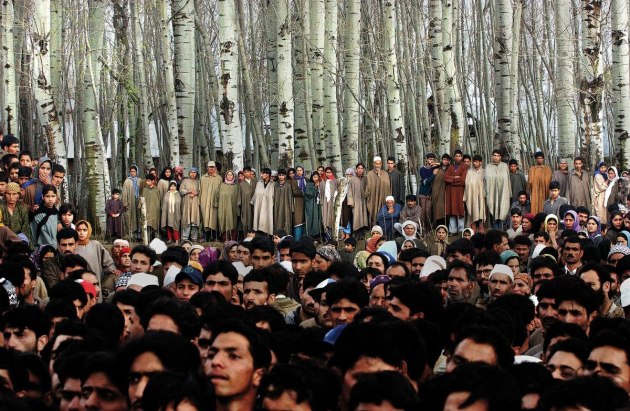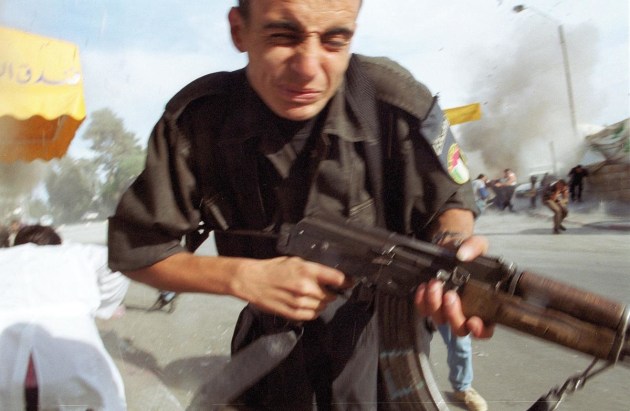Ami Vitale: the voice where it's needed most
Over the last few years, Ami Vitale’s name has become synonymous with images of the world’s dwindling megafauna. After her documentation of the last white rhinos and the efforts to mitigate their extinction, Vitale has moved on to cover similar efforts around the globe, most notably in her coverage of China’s giant panda recovery for National Geographic. But the road to shooting arguably some of the planet’s most important stories for some of its biggest publications was not a simple one for Vitale. Sam Edmonds explains.
A fairly safe gauge of any photographer’s ultimate success might be when they find themselves on a TED stage. Most often reserved for uber-documentarians like Sebastião Salgado, James Nachtwey, and Aaron Huey, an offer to make a TED talk means you have something really worth telling people about. And Ami Vitale is no exception to this rule. From a stage in Shanghai, Vitale captivated an audience as she recounted her journey through photography from her upbringing in America’s most leisurely state, Florida, to the front lines of war correspondent work and finally to the rifle-guarded rhinos of Africa. But while Vitale’s presentation speaks volumes as to the depths, the triumphs, and the ongoing ecological issues of human beings, her personal development as a storyteller is equally compelling. And as someone who was described as an extremely shy child, to make such a compelling case on a TED stage seems an achievement in itself.

To some extent, Vitale’s body of work reflects so much of the human condition. From her formative years covering conflict in the Middle East to her intimate portraits of those species suffering at the hands of poaching and the ivory trade, to view Vitale’s work is to glean a synopsis of the underlying issues of our time. From a self-described “incredibly introverted” child to a documentarian of humanity’s largest struggles, Vitale’s metamorphosis was largely influenced by her craft, and what was once her “passport to engaging with the world” eventually became her tool for changing it.
Formative years
For many photographers, and especially photojournalists, personal development into a mature, politically informed young adult remains the key foundation for any successful career as a storyteller. But for Vitale, the importance of this process was particularly significant as she developed from a shy American kid to the powerhouse of photography. What she represents today was in many ways shaped by her tool of choice: the camera. “I was incredibly introverted, very shy, and I found that the camera became my passport to engaging with the world around me. And by putting attention on others, it empowered me,” Vitale says. “What I never imagined was that by empowering myself, I was also empowering others. Photography became this incredible tool for creating awareness and understanding across cultures, and countries; a tool to make sense of our commonalities in the world we share,” she says.
The steep section of Vitale’s learning curve didn’t end there. As she learned to hone her voice as a visual practitioner, Vitale was employed by a newspaper in Eastern Europe and subsequently began covering the conflict in Kosovo in the late nineties. From here, she took on the life of the typical jet-setting photojournalist, graduating to covering the conflict in Israel and Palestine, and coming to many realisations about her craft while amidst the rubble and chaos of religion-fuelled animosity. But this proximity to destruction became all too close one day when Vitale’s life was spared only by a fortuitous camera battery fault. “There was a police station in Gaza where two Israeli soldiers had been taken and an angry mob took over. I was running to get close to document the scene unfolding,” she recounts. “As I was running there, the batteries in my camera fell out and in the moment when I stopped to pick them up, a helicopter with a missile came in close and vaporised the building I was running to get to. It saved my life. I would have been inside that building doing what I thought I should be doing: getting close to the action.”

from a family in Badgam district of Kashmir, 10 March, 2004.
On another occasion, Vitale was photographing a funeral in Palestine. Having spent most of the day with the women, she went to see the body being taken in. “A man in the procession started screaming, ‘CIA agent’ and pointing at me,” Vitale recalls. “I was surrounded by hundreds of angry men, screaming in my face, grabbing me. I was terrified, and thought, “This is it. I am going to die.” Suddenly, I understood a mob. There’s no thinking, just passion.” Through sheer luck, one of the women that Vitale has spent the day with managed to pull her away. That moment, Vitale says, changed her perspective. She also realised that no picture is worth putting yourself in such grave danger.
But it wasn’t only her life that Vitale was thankful to leave the conflict zone with. Covering some of the world’s most volatile communities left her with a sense of wonder for the more intimate, overlooked scenes. “I was taught to react to events and be close to the action, but I slowly learned that it’s the quiet moments that matter the most,” she says. “They take more work, but it’s important not to just ‘react’ to news, but search for deeper meanings and learn the ‘why’ of the world.”

in the summer capital of Srinagar, in the Indian-held state of Kashmir, 19 February, 2002.
Human nature
While Vitale developed a name for herself as a photographer on the front lines of war, in subsequent years her body of work has become most synonymous with documenting the plight of some the planet’s most ecologically precarious species. In assignments for National Geographic and other monolithic publications, her work has exposed the efforts being made to both conserve and protect the individuals of several soon-to-be-extinct animal populations.
Although this switch from war to conservation might seem like somewhat of a sea change, Vitale describes the common ground between these two spheres as uniquely human. “I realised as I take pictures of people and cultures, that even for wildlife and nature stories, I can bring that same sensibility into the images,” she says. “Here is the thing that really struck me: everything is connected to nature. It’s not really about animals, it’s really about us. I’m not a nature photographer. I use nature as the foil, but it’s about us, our future, and where we are going. I’ve focused on continuing to tell the story of what connects us all, but now I am using the lens of nature: our home.”

This was perhaps most famously illustrated in Vitale’s 2009 essay on the Northern White Rhinos – large, majestic animals that once roamed East and Central Africa freely. Today, only three of these animals remain on the planet and are protected by armoured guards around the clock – a tense situation borne of humans’ insatiable desire for ivory. “Rhino horns have become so valuable that they are worth more than gold right now,” says Vitale. “People believe the material of the horn, when ground up, has magical cures, but the reality is that the horns are made of keratin – exactly the same thing in our fingernails.” But despite the facts, Vitale says poaching is not showing any signs of slowing down. “It’s entirely possible, even likely, that if the current trajectory of killing continues, rhinos, along with elephants and a host of lesser known plains animals will be functionally extinct in our lifetime,” she says. “Much needed attention has been focused on the plight of wildlife and the conflict between heavily armed poachers and increasingly militarised wildlife rangers, but very little has been said about the indigenous communities on the frontlines of the poaching wars and the incredible work they do to protect these animals. These communities hold the key to saving Africa’s great animals.”
Perhaps nodding to the dire need for future generations of conservation photographers, it’s in these issues like that of the Northern White Rhino and her other body of seminal work covering China’s Giant Pandas that Vitale has so intimately reflected both the callous disregard and the glorious care of our own species. While both these stories depict people’s ability to ignore any semblance of our ecological footprints, both also bear witness to our ability to change – a story that needs to continue to be told. And while Vitale admits that working for the planet’s most prestigious publication is incredibly difficult work, she offers some advice for budding conservation photographers: “Everyone is a photographer these days. I would study science and develop a real skill and knowledge for something other than photography. But if you do pursue it as a craft, you’ve got to find a project you really care about and work on it for years,” she says. “Make it yours. Make it unique. Don’t shoot what you think people are going to like. Shoot from your heart and find your own style and passion. It’s important to go deep and spend time – at least a whole year – on one story. Pictures are more than just a beautiful image. They need to convey meaning and story.”

of Ramallah, 11 October, 2000.
Focus on goodness
From the span of her career thus far, it is tempting to conclude that the accumulation of Vitale’s experiences would lead to a less-than-optimistic outlook on the state of our planet. But just the opposite is true. In front of her wide-eyed audience in the TED auditorium, Vitale’s presentation, now feeling like a whirlwind tour of humanity’s least proud moments of the last decade, concludes with an inspiring montage of panda cubs – a symbol that people are capable of redeeming themselves. Referring again to her own metamorphosis, Vitale leaves us with the sentiment that while headlines often serve as nothing more than food for depression, it is important to look beyond the sensationalism. “Every story has a variety of viewpoints and truths depending on where you stand. It really takes tremendous time and patience to get to the subtleties and nuances of any story,” she says. And in a final statement imploring her audience to focus
on humanity’s redemption, Vitale seems to sum up her career in a couple of sentences. “We do need to focus on the challenges of the world, but if we only tell it in a negative way, we are on a fast race to the bottom. The world is a beautiful place. We need to celebrate the goodness, because it is everywhere.”
Contact
Website: amivitale.com
Instagram: www.instagram.com/amivitale
Facebook: www.facebook.com/amivitale1
Twitter: https://twitter.com/Amivee
Read more about Vitale's recent trip to Kenya, and a heartbreaking farewell...www.capturemag.com.au/projects/farewell-to-the-last-of-a-species

Get more stories like this delivered
free to your inbox. Sign up here.


